Abstract
1. The time course and extent of changes in the composition of renal tissue slices in osmotic diuresis were determined by sacrificing groups of rats before and during the intravenous infusion of mannitol (15 g/100 ml.) for up to 7½ hr.
2. Very rapid changes in tissue water and solute contents occurred within 15 min, preceding the times of maximal diuresis, with little subsequent change even up to 7½ hr.
3. The main changes were:
(a) an increase in water content in all slices, particularly the papilla; (b) a very profound decrease in papillary and medullary urea content in the first 15 min, with a small, but significant, further decrease, subsequently; (c) a small, but significant, rapid decrease in papillary sodium, and small non-significant increases in the outer medulla and cortex. Subsequent changes in any segment were small and non-significant; (d) apart from small changes in the first 15 min ammonium and potassium contents remained fairly constant.
4. The rates of change in papillary and urinary urea concentrations were similar, so that after 30 min, any differences between tip and urinary concentrations were small and non-significant.
5. The findings are discussed in terms of factors influencing counter-current mechanisms. It is concluded that altered medullary blood flow is mainly responsible for the rapid changes in medullary composition.
6. The relation between papillary and urinary urea concentrations is explicable in terms of passive handling, with equilibration across a freely permeable collecting duct membrane.
Full text
PDF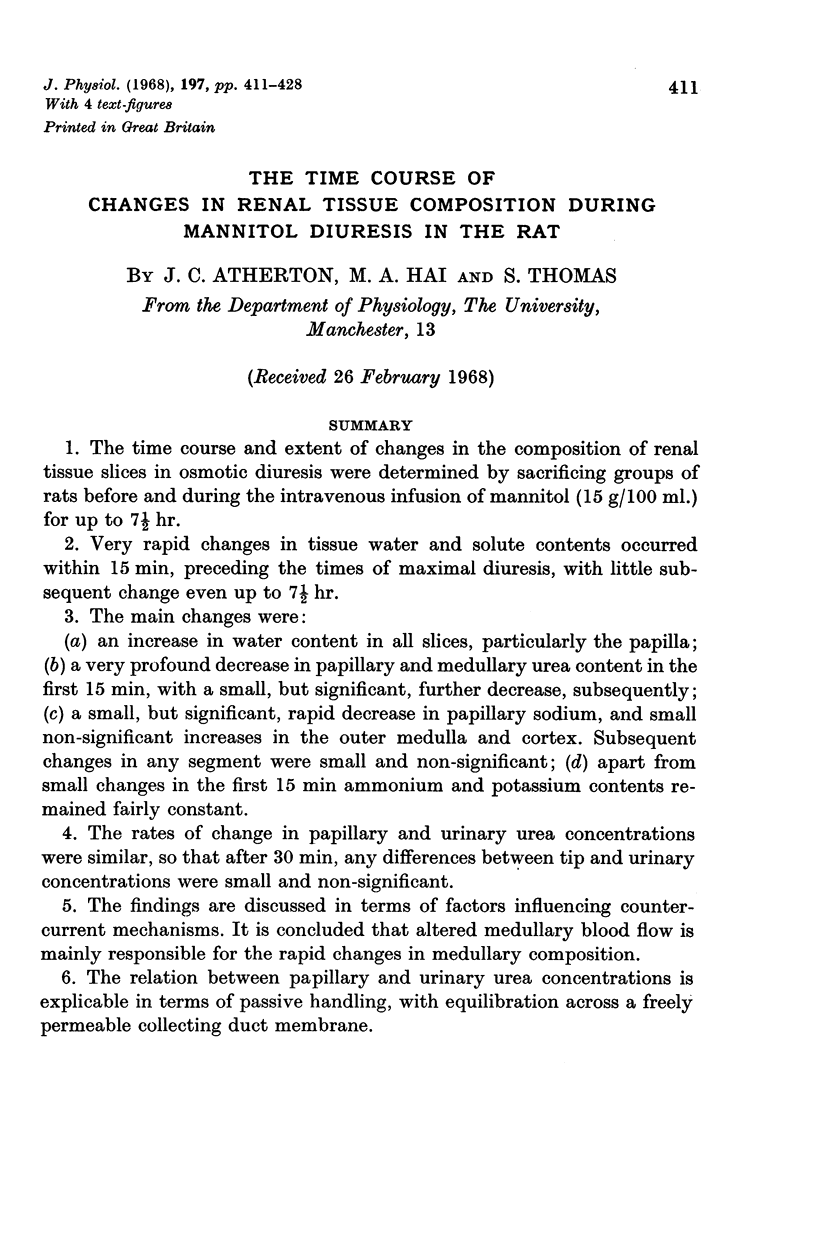
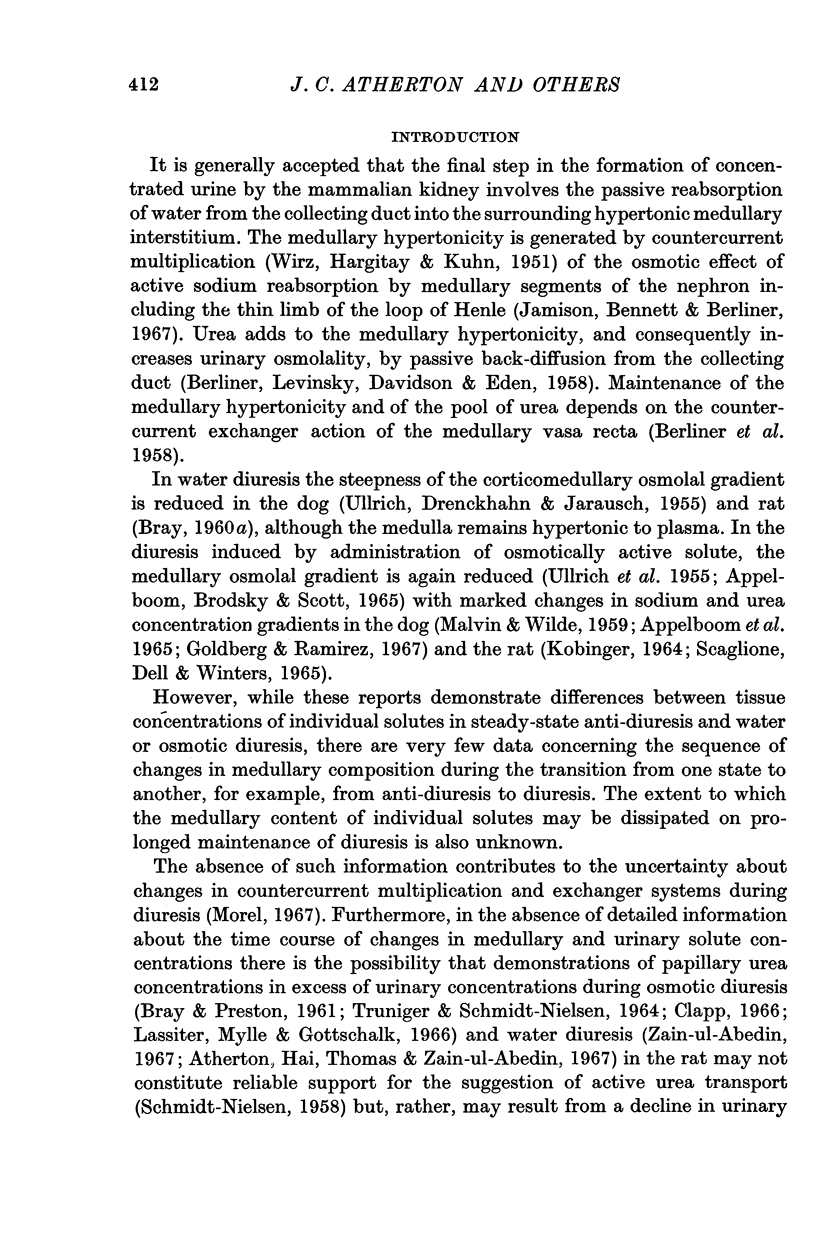





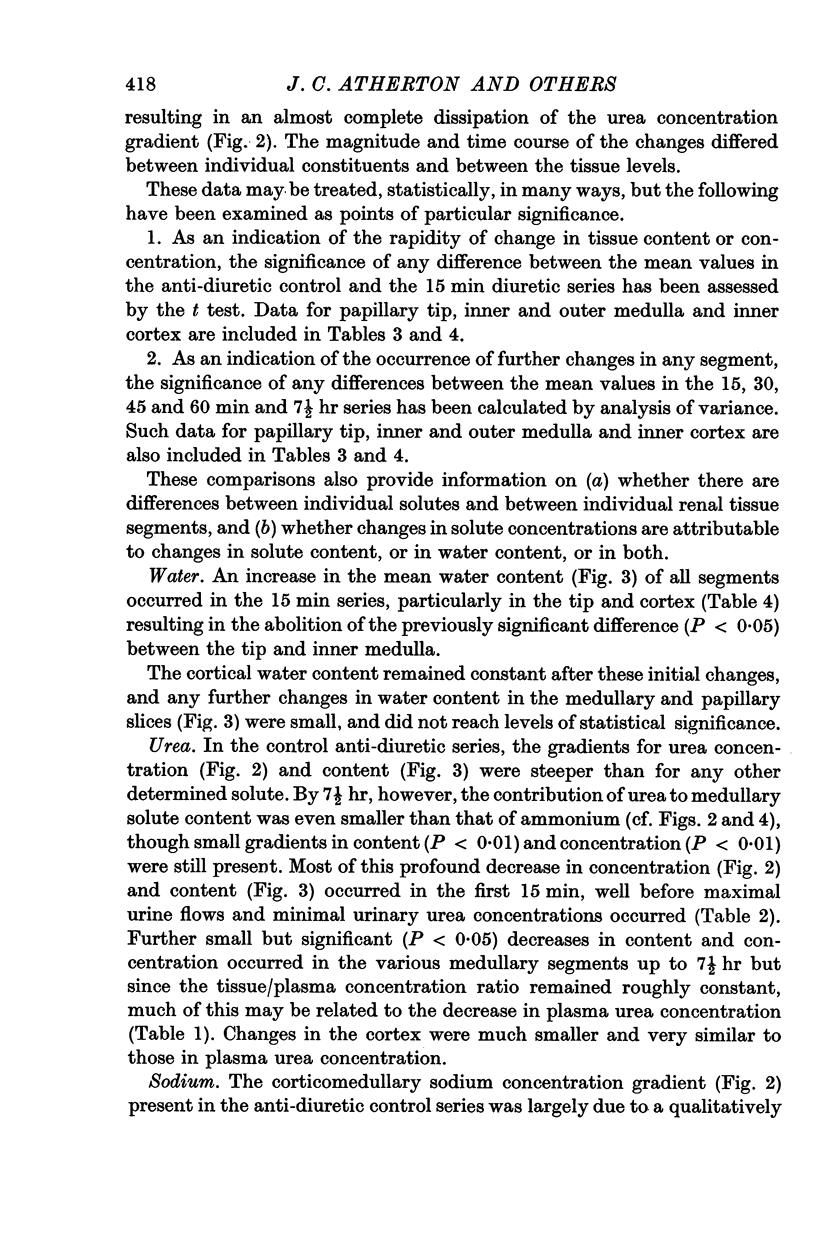


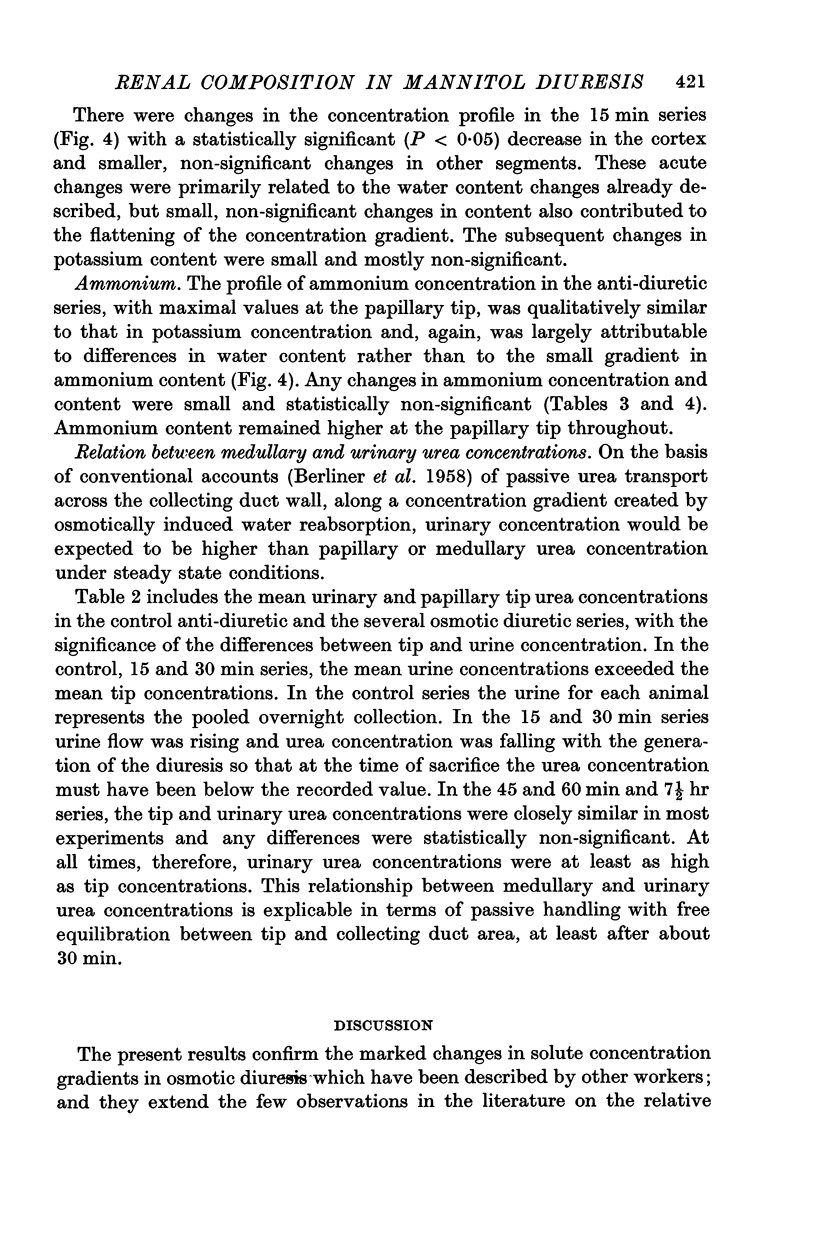
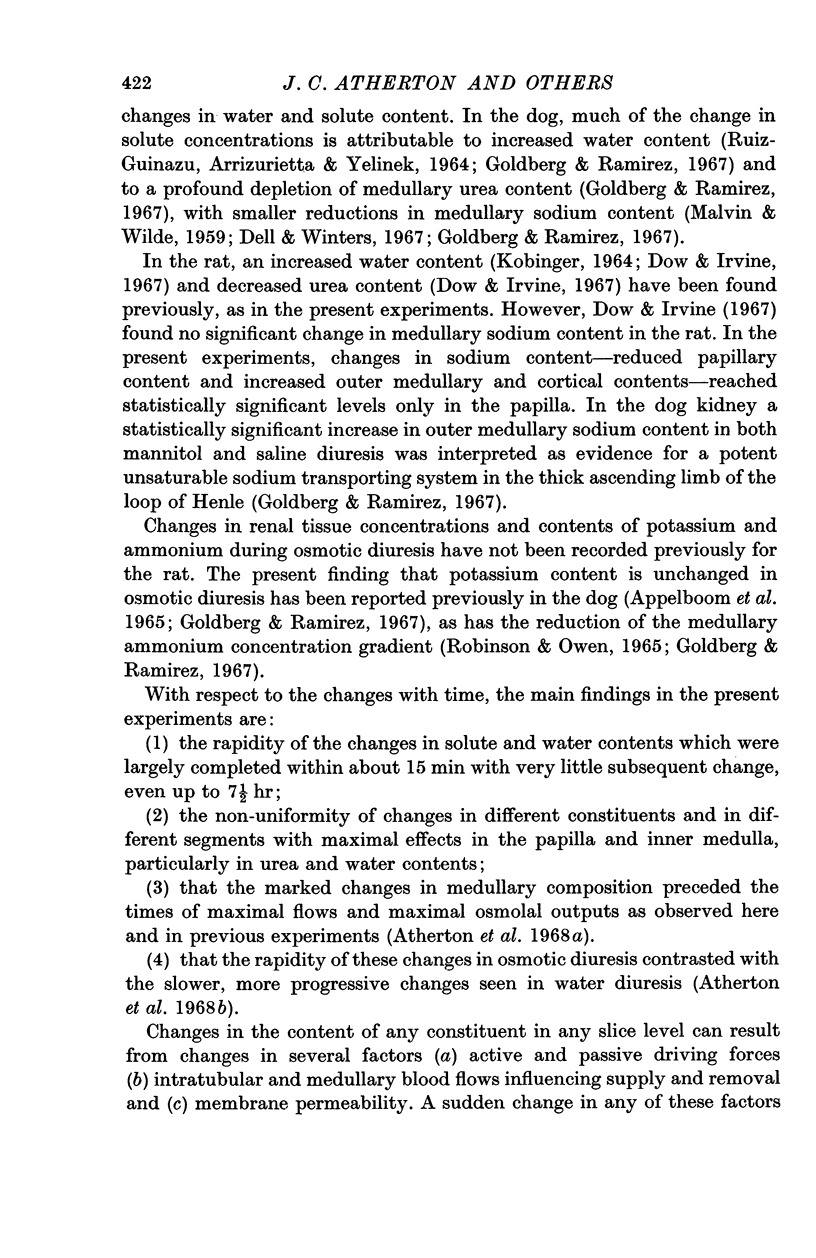


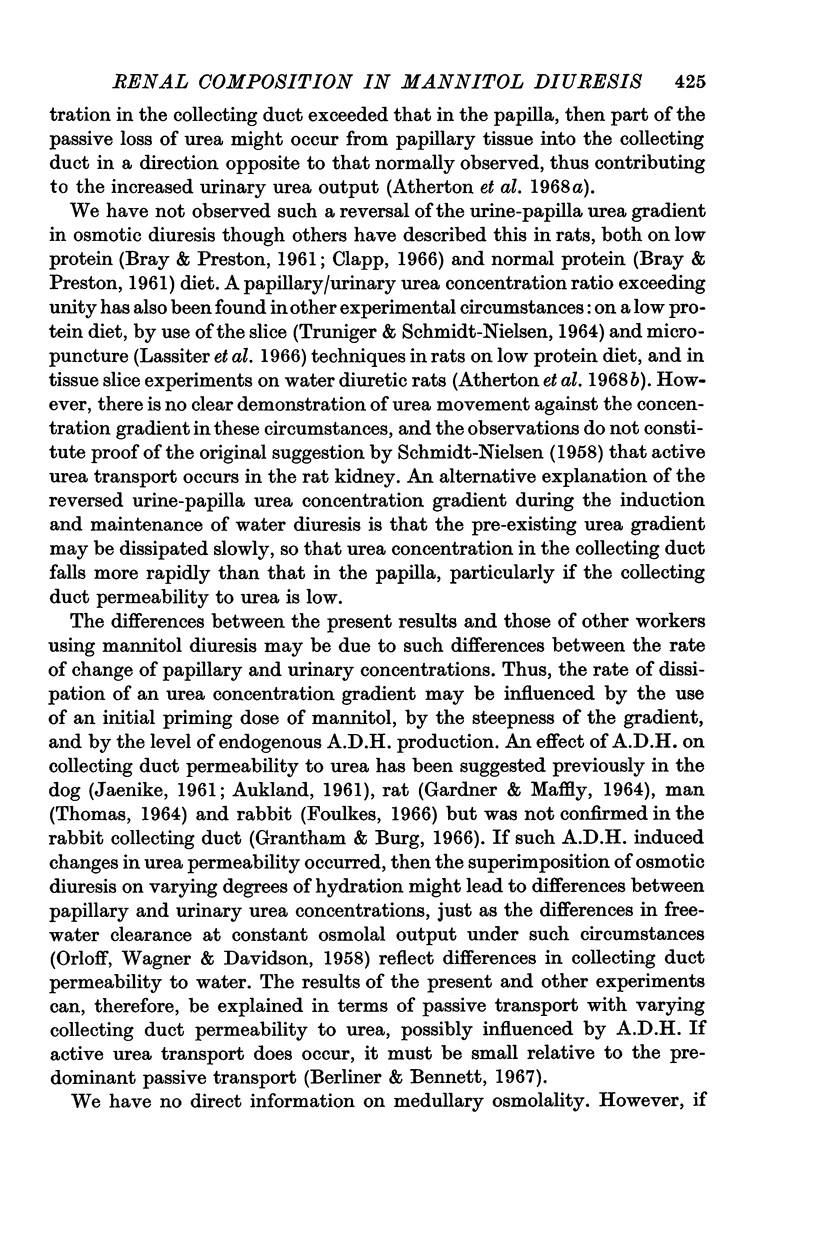



Selected References
These references are in PubMed. This may not be the complete list of references from this article.
- APPELBOOM J. W., BRODSKY W. A., SCOTT W. N. EFFECT OF OSMOTIC DIURESIS ON INTRARENAL SOLUTES IN DIABETES INSIPIDUS AND HYDROPENIA. Am J Physiol. 1965 Jan;208:38–45. doi: 10.1152/ajplegacy.1965.208.1.38. [DOI] [PubMed] [Google Scholar]
- AUKLAND K. Renal tubular permeability to urea with special reference to accumulation of urea in the renal medulla. Scand J Clin Lab Invest. 1961;13:646–660. doi: 10.3109/00365516109137339. [DOI] [PubMed] [Google Scholar]
- Atherton J. C., Hai M. A., Thomas S. Effects of water diuresis and osmotic (mannitol) diuresis on urinary solute excretion by the conscious rat. J Physiol. 1968 Jul;197(2):395–410. doi: 10.1113/jphysiol.1968.sp008566. [DOI] [PMC free article] [PubMed] [Google Scholar]
- Atherton J. C., Hai M. A., Thomas S. The time course of changes in renal tissue composition duruig water diuresis in the rat. J Physiol. 1968 Jul;197(2):429–443. doi: 10.1113/jphysiol.1968.sp008568. [DOI] [PMC free article] [PubMed] [Google Scholar]
- BERLINER R. W., LEVINSKY N. G., DAVIDSON D. G., EDEN M. Dilution and concentration of the urine and the action of antidiuretic hormone. Am J Med. 1958 May;24(5):730–744. doi: 10.1016/0002-9343(58)90377-2. [DOI] [PubMed] [Google Scholar]
- BRAY G. A., PRESTON A. S. Effect of urea on urine concentration in the rat. J Clin Invest. 1961 Nov;40:1952–1960. doi: 10.1172/JCI104420. [DOI] [PMC free article] [PubMed] [Google Scholar]
- Berliner R. W., Bennett C. M. Concentration of urine in the mammalian kidney. Am J Med. 1967 May;42(5):777–789. doi: 10.1016/0002-9343(67)90095-2. [DOI] [PubMed] [Google Scholar]
- Clapp J. R. Renal tubular reabsorption of urea in normal and protein-depleted rats. Am J Physiol. 1966 Jun;210(6):1304–1308. doi: 10.1152/ajplegacy.1966.210.6.1304. [DOI] [PubMed] [Google Scholar]
- Dell R. B., Winters R. W. Lactate gradients in the kidney of the dog. Am J Physiol. 1967 Aug;213(2):301–307. doi: 10.1152/ajplegacy.1967.213.2.301. [DOI] [PubMed] [Google Scholar]
- Foulkes E. C. The action of pitressin on solute permeability of the rabbit nephron in vivo. J Gen Physiol. 1966 Sep;50(1):1–8. doi: 10.1085/jgp.50.1.1. [DOI] [PMC free article] [PubMed] [Google Scholar]
- GARDNER K. D., Jr, MAFFLY R. H. AN IN VITRO DEMONSTRATION IN INCREASED COLLECTING TUBULAR PERMEABILITY TO UREA IN THE PRESENCE OF VASOPRESSIN. J Clin Invest. 1964 Oct;43:1968–1975. doi: 10.1172/JCI105070. [DOI] [PMC free article] [PubMed] [Google Scholar]
- GOTTSCHALK C. W., MYLLE M. Micropuncture study of the mammalian urinary concentrating mechanism: evidence for the countercurrent hypothesis. Am J Physiol. 1959 Apr;196(4):927–936. doi: 10.1152/ajplegacy.1959.196.4.927. [DOI] [PubMed] [Google Scholar]
- Gardner K. D., Jr Dry weight as a point of reference in studies of renal papillary composition. Am J Physiol. 1966 Oct;211(4):1031–1035. doi: 10.1152/ajplegacy.1966.211.4.1031. [DOI] [PubMed] [Google Scholar]
- Goldberg M., Ramirez M. A. Effects of saline and mannitol diuresis on the renal concentrating mechanism in dogs: alterations in renal tissue solutes and water. Clin Sci. 1967 Jun;32(3):475–493. [PubMed] [Google Scholar]
- Grantham J. J., Burg M. B. Effect of vasopressin and cyclic AMP on permeability of isolated collecting tubules. Am J Physiol. 1966 Jul;211(1):255–259. doi: 10.1152/ajplegacy.1966.211.1.255. [DOI] [PubMed] [Google Scholar]
- JAENIKE J. R. The influence of vasopressin on the permeability of the mammalian collecting duct to urea. J Clin Invest. 1961 Jan;40:144–151. doi: 10.1172/JCI104228. [DOI] [PMC free article] [PubMed] [Google Scholar]
- Jamison R. L., Bennett C. M., Berliner R. W. Countercurrent multiplication by the thin loops of Henle. Am J Physiol. 1967 Feb;212(2):357–366. doi: 10.1152/ajplegacy.1967.212.2.357. [DOI] [PubMed] [Google Scholar]
- Jones N. F., Mylle M., Gottschalk C. W. Renal tubular microinjection studies in normal and potassium-depleted rats. Clin Sci. 1965 Oct;29(2):261–275. [PubMed] [Google Scholar]
- KOBINGER W. DIE WIRKUNG VON VASOPRESSIN AUF DIE KONZENTRATIONSGRADIENTEN VON NATRIUM UND HARNSTOFF IM NIERENGEWEBE BEI VERSCHIEDENEN DIURESEZUSTAENDEN. Naunyn Schmiedebergs Arch Exp Pathol Pharmakol. 1964 Mar 19;246:538–551. doi: 10.1007/BF00246307. [DOI] [PubMed] [Google Scholar]
- LILIEN O. M., JONES S. G., MUELLER C. B. THE MECHANISM OF MANNITOL DIURESIS. Surg Gynecol Obstet. 1963 Aug;117:221–228. [PubMed] [Google Scholar]
- Lassiter W. E., Mylle M., Gottschalk C. W. Micropuncture study of urea transport in rat renal medulla. Am J Physiol. 1966 May;210(5):965–970. doi: 10.1152/ajplegacy.1966.210.5.965. [DOI] [PubMed] [Google Scholar]
- MALVIN R. L., WILDE W. S. Washout of renal countercurrent Na gradient by osmotic diuresis. Am J Physiol. 1959 Jul;197(1):177–180. doi: 10.1152/ajplegacy.1959.197.1.177. [DOI] [PubMed] [Google Scholar]
- MOREL F. F., GUINNEBAULT M., AMIEL C. [Demonstration of a process of water exchange by counter-current in the deep regions of the hamster kidney]. Helv Physiol Pharmacol Acta. 1960;18:183–192. [PubMed] [Google Scholar]
- ORLOFF J., WAGNER H. N., Jr, DAVIDSON D. G. The effect of variations in solute excretion and vasopressin dosage on the excretion of water in the dog. J Clin Invest. 1958 Mar;37(3):458–464. doi: 10.1172/JCI103625. [DOI] [PMC free article] [PubMed] [Google Scholar]
- PILKINGTON L. A., BINDER R., DEHAAS J. C., PITTS R. F. INTRARENAL DISTRIBUTION OF BLOOD FLOW. Am J Physiol. 1965 Jun;208:1107–1113. doi: 10.1152/ajplegacy.1965.208.6.1107. [DOI] [PubMed] [Google Scholar]
- ROBINSON R. R., OWEN E. E. INTRARENAL DISTRIBUTION OF AMMONIA DURING DIURESIS AND ANTIDIURESIS. Am J Physiol. 1965 Jun;208:1129–1134. doi: 10.1152/ajplegacy.1965.208.6.1129. [DOI] [PubMed] [Google Scholar]
- Ruiz-Guiñazú A., Arrizurieta E. E., Yelinek L. Electrolyte, water, and urea content in dog kidneys in different states of diuresis. Am J Physiol. 1964 Apr;206(4):725–730. doi: 10.1152/ajplegacy.1964.206.4.725. [DOI] [PubMed] [Google Scholar]
- SAIKIA T. C. COMPOSITION OF THE RENAL CORTEX AND MEDULLA OF RATS DURING WATER DIURESIS AND ANTIDIURESIS. Q J Exp Physiol Cogn Med Sci. 1965 Apr;50:146–157. doi: 10.1113/expphysiol.1965.sp001777. [DOI] [PubMed] [Google Scholar]
- SCHMIDT-NIELSEN B. Urea excretion in mammals. Physiol Rev. 1958 Apr;38(2):139–168. doi: 10.1152/physrev.1958.38.2.139. [DOI] [PubMed] [Google Scholar]
- STAHL W. M. EFFECT OF MANNITOL ON THE KIDNEY: CHANGES IN INTRARENAL HEMODYNAMICS. N Engl J Med. 1965 Feb 25;272:382–386. doi: 10.1056/NEJM196502252720801. [DOI] [PubMed] [Google Scholar]
- Scaglione P. R., Dell R. B., Winters R. W. Lactate concentration in the medulla of rat kidney. Am J Physiol. 1965 Dec;209(6):1193–1198. doi: 10.1152/ajplegacy.1965.209.6.1193. [DOI] [PubMed] [Google Scholar]
- THOMAS S. SOLUTE EXCRETION IN MAN DURING CHANGING URINE FLOW OCCURRING SPONTANEOUSLY AND INDUCED BY VASOPRESSIN INJECTION. J Clin Invest. 1964 Jan;43:1–10. doi: 10.1172/JCI104883. [DOI] [PMC free article] [PubMed] [Google Scholar]
- TRUNIGER B., SCHMIDT-NIELSEN B. INTRARENAL DISTRIBUTION OF UREA AND RELATED COMPOUNDS: EFFECTS OF NITROGEN INTAKE. Am J Physiol. 1964 Nov;207:971–978. doi: 10.1152/ajplegacy.1964.207.5.971. [DOI] [PubMed] [Google Scholar]
- ULLRICH K. J., DRENCKHAHN F. O., JARAUSCH K. H. Untersuchungen zum Problem der Harnkonzentrierung und -verdünnung; uber das osmotische Verhalten von Nierenzellen und die begieitende Elektrolytanhäufung im Nierengewebe bei verschiedenen Diuresezuständen. Pflugers Arch. 1955;261(1):62–77. doi: 10.1007/BF00363541. [DOI] [PubMed] [Google Scholar]
- ULLRICH K. J., KRAMER K., BOYLAN J. W. Present knowledge of the counter-current system in the mammalian kidney. Prog Cardiovasc Dis. 1961 Mar;3:395–431. doi: 10.1016/s0033-0620(61)80001-7. [DOI] [PubMed] [Google Scholar]
- ULLRICH K. J., SCHMIDT-NIELSON B., O'DELL R., PEHLING G., GOTTSCHALK C. W., LASSITER W. E., MYLLE M. Micropuncture study of composition of proximal and distal tubular fluid in rat kidney. Am J Physiol. 1963 Apr;204:527–531. doi: 10.1152/ajplegacy.1963.204.4.527. [DOI] [PubMed] [Google Scholar]
- Valtin H. Sequestration of urea and nonurea solutes in renal tissues of rats with hereditary hypothalamic diabetes insipidus: effect of vasopressin and dehydration on the countercurrent mechanism. J Clin Invest. 1966 Mar;45(3):337–345. doi: 10.1172/JCI105348. [DOI] [PMC free article] [PubMed] [Google Scholar]
- WINDHAGER E. E., GIEBISCH G. Micropuncture study of renal tubular transfer of sodium chloride in the rat. Am J Physiol. 1961 Mar;200:581–590. doi: 10.1152/ajplegacy.1961.200.3.581. [DOI] [PubMed] [Google Scholar]
- WIRZ H., HARGITAY B., KUHN W. Lokalisation des Konzentrierungsprozesses in der Niere durch direkte Kryoskopie. Helv Physiol Pharmacol Acta. 1951 Jun;9(2):196–207. [PubMed] [Google Scholar]
- Zain-ul-Abedin Effects of vasopressin upon the composition of rat's kidney. Q J Exp Physiol Cogn Med Sci. 1967 Jul;52(3):285–292. doi: 10.1113/expphysiol.1967.sp001914. [DOI] [PubMed] [Google Scholar]


